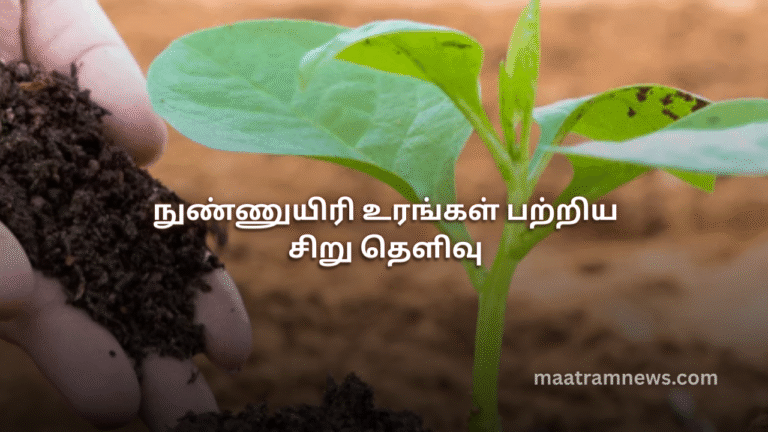நுண்ணுயிரி உரங்கள் பற்றிய சிறு தெளிவு
🍃🍃🍃🍃🍃🍃🍃🍃🍃
நுண்ணுயிர்கள் என்றாலே மனிதனுக்கு எதிரானவை என்ற பொதுவான எண்ணம் பாமரர் மட்டுமன்றி மெத்தப் படித்தவர்கள் மத்தியிலும் கூட உண்டு.
உண்மையில் அப்படியில்லை. இயற்கை தனது அனைத்து படைப்பிலும் இரண்டு வாசல்களை வைத்தே இருக்கிறது. ஒரு வாசல் அடைத்தால், இன்னொரு வாசல் திறக்கும். அதன்படி, தீமை செய்யும் நுண்ணுயிர்களைக் கட்டுப்படுத்த, சில நன்மை செய்யும் நுண்ணுயிர்களையும் இயற்கை படைத்துள்ளது.
ஒரு கிராம் மண்ணில் பல கோடி நுண்ணுயிர்கள், மண்ணுக்கும் உயிரினங்களுக்கும் பயிர்களுக்கும் உதவிக்கொண்டே இருக்கின்றன. மண்ணில் உள்ளது போல் நம் உடலும் நன்மை செய்யக்கூடிய பக்டீரியாக்கள் அதிகமுள்ளன.
இத்தனை நன்மை செய்யும் நுண்ணுயிர்களை, விவசாயத்தில் பயன்படுத்தலாம் என்பதை முதன்முதலில் கண்டுபிடித்தவர், சோவியத் ரஷ்யாவைச் சேர்ந்த விஞ்ஞானி, வின்கரோட்ஸ்கி. அவர் கண்டுபிடித்த, அசோஸ்பைரில்லம்தான் (Azospirillum) முதன் முதலில் கண்டுபிடிக்கப்பட்ட முதல் உயிர் உரம்.
1929-ம் ஆண்டில் இது கண்டுபிடிக்கப்பட்டாலும், இன்னமும் கூட நம் இலங்கை நாட்டின் இயற்கை விவசாயிகளை முழுமையாகச் சென்றடையவில்லை, ஏன் இயற்கை விவசாயம் செய்யும் பலர் இதைப்பற்றிக் கேள்விப்படக்கூடவில்லை என்பது நிலைபேறான விவசாய வளர்ச்சியில் எமது நிலையினைச் சுட்டிக்காட்டி நிற்கிறது.
இயற்கை விவசாயத்தில் நாம், நெதர்லாந்து, இந்தியாவை விட எவ்வளவு தூரம் பின்தங்கி உள்ளோம் என்பதை இதைவிடச் சொல்லிப்புரியவைக்கத் தேவையில்லை.
அசோஸ்பைரில்லத்துக்குப் பிறகுதான் ஒவ்வொரு சத்துக்களையும் கரைக்கக்கூடிய நுண்ணுயிர்கள் பயன்பாட்டுக்கு வந்தன. சூடோமோனஸ், பொஸ்போ பக்டீரியா எனப் பலவகையான உயிர் உரங்கள் இப்போது பயன்பாட்டில் உள்ளன. இந்திய விவசாயிகள் உயிர் உரங்களை அதிகளவில் பயன்படுத்த தொடங்கியிருக்கிறார்கள் என்பது ஆறுதலான செய்தி.
செயற்கையாக நாம் கொடுக்கும் உயிர் உரங்கள், ஒருபுறம் இருந்தாலும், மண்ணில் உள்ள கோடிக்கணக்காண நுண்ணுயிர்கள்தான், பன்னெடுங்காலமாக விவசாயிகளுக்கு உதவியாக இருந்து வருகின்றன என்பதை நாம் கவனத்தில் கொள்ள வேண்டும்.
இவற்றை காக்க நாம் என்ன செய்திருக்கிறோம்?
மனிதர்களுக்குத் தேவைப்படுவது போலவே, நுண்ணுயிர்களுக்கும் உணவும் உறைவிடமும் அவசியம். மண்ணில் விழும் பொருள்களைச் சிதைத்து, அதில் இருந்துதான் நுண்ணுயிர்கள் தங்களுக்கான உணவை எடுத்துக்கொள்கின்றன. அதைத்தான் நாம் ‘மக்குதல்/. உக்குதல்’ என்கிறோம். ஒரு பொருளை மக்க வைத்து, தனது உணவுத் தேவையைப் பூர்த்திச் செய்தவுடன் , அதைத் தாதுக்களாக மாற்றி, தாவரங்களுக்குக் கொடுக்கும் பணியைச் செய்கின்றன, நுண்ணுயிர்கள்.
நம் பாரம்பரிய விவசாயத்தில் பயன்படுத்தி வரும் தொழுவுரம் (எரு), நுண்ணுயிர்களுக்கான ஆகச் சிறந்த உணவு. காலப்போக்கில் தொழுவுரங்களை குறைத்துவிட்டு, குப்பை உரங்கள் என்ற பெயரில் நகரத்து குப்பைகளைக் கொட்டுகிறோம். இதில், எளிதில் உக்காத உள்ளிட்ட பல பொருள்கள் கலந்திருக்கின்றன.
மண்ணுக்கு நல்ல தொழுவுரம் கொடுத்தாலே, நுண்ணுயிர்களுக்குப் போதுமான உணவு கிடைப்பதுடன், மண்ணில் உள்ள சேதன சத்துக்களும் (நைதரசன், பொட்டாசியம், பொஸ்பரஸ்) அதிகரிக்கும்.
நம் முன்னோர்களுக்கு விவசாயத்தில் வெற்றிகரமாக உதவிய, நம் தலைமுறை சில தசாப்தங்கள் முன், பசுமைப்புரட்சி எனும் பெயரில், ஆட்டுமந்தைக் கோட்பாட்டின் மூலம், நம் இரு தலைமுறைகள் காலத்தில் இழந்த நுண்ணுயிர்களை மீட்டெடுக்க நிலத்தில் தொழுவுரம் மற்றும் சேதன உரப் பயன்பாட்டை அதிகரிக்க வேண்டும்.
நுண்ணுயிர்கள் சேவை, மண்ணோடு நின்று விடுவதில்லை. உயிரினங்களின் உடல் உறுப்புகளிலும் இவை பணியாற்றுகின்றன. உதாரணமாக, நாம் உண்ணும் உணவைச் செரிக்க வைப்பது, குடலில் உள்ள ‘லக்டோபசிலஸ்’ எனும் நுண்ணுயிரி. எமது உணர்வுகள் கூட நுண்ணுயிர்களில் தங்கியுள்ளதாக சில ஆய்வுகள் கூறுகின்றன.
நுண்ணுயிர்களான, கோடிக்கணக்கான உயிர்கள் இந்த உலகை உயிர்ப்புடன் வைத்திருப்பதற்காக ஓயாது உழைத்துக்கொண்டே இருக்கின்றன என்பதை நாம் நினைவில் வைத்துக்கொள்ள வேண்டும்.
நுண்ணுயிர் உரங்களை இலங்கையில் அங்கீகரிக்க, அரசு, தேவையான ஏற்பாடுகளை செய்வதானது இன்றியமையாதது மற்றும் காலத்தின் தேவை. இது இயற்கை விவசாயத்தை நிலைபேறாக அடுத்த கட்டத்திற்குக் கொண்டு சென்று, இரசாயன விவசாயத்துடன் போட்டி போட்டு, தாக்குப்பிடித்து வளரும் ஓர் நிலையை நிச்சயம் உருவாக்கும்.
மேலதிக விபரங்களுக்கு
CSJ Agri
076 225 0017
மேலதிக தகவல்களுக்கு மாற்றம் செய்திகள் இணையத்தளத்தினுள் பிரவேசியுங்கள்.
மேலதிக தகவல்களை உடனுக்குடன் பெற்றுக்கொள்ள மாற்றம் செய்திகள் முகநூல் பக்கத்தை பின்தொடரவும்.
A Brief Insight into Biofertilizers
🍃🍃🍃🍃🍃🍃🍃🍃🍃
There is a common belief, not only among ordinary people but even among the educated, that microbes are harmful to humans.
In reality, that is not the case. Nature has created two pathways in all its creations. If one door closes, another opens. Accordingly, to counter harmful microbes, nature has also created beneficial microbes.
In just one gram of soil, billions of microbes exist, continuously helping the soil, living beings, and crops. Just as in soil, our bodies too are filled with beneficial bacteria.
The first person to discover that such microbes can be used in agriculture was the Soviet Russian scientist Sergei Winogradsky. The first biofertilizer he discovered was Azospirillum.
Although it was discovered in 1929, it has still not fully reached natural farmers in Sri Lanka. Many engaged in organic farming have never even heard of it — a clear sign of how far behind we are in sustainable agricultural development.
Compared to countries like the Netherlands and India, we lag significantly in adopting biofertilizers. After Azospirillum, many other nutrient-solubilizing microbes were introduced — such as Pseudomonas and Phosphobacteria, which are now widely used. The fact that Indian farmers have begun using biofertilizers on a large scale is indeed encouraging.
Even though artificially produced biofertilizers are important, the billions of microbes already present in the soil have been supporting farmers for countless generations. We must recognize their value.
But what have we done to protect them?
Just as humans need food and shelter, microbes too require nourishment and a habitat. They feed on organic matter that falls into the soil, breaking it down. This process is what we call decomposition/fermentation. After feeding, microbes transform the material into nutrients and supply them to plants.
In traditional farming, farmyard manure (cow dung compost) has always been the best food for microbes. Over time, we reduced its use and began dumping city garbage in the name of compost. These contain many non-decomposable materials, which harm the soil.
If we provide good quality farmyard manure to the soil, microbes will receive adequate food, while organic nutrients such as nitrogen, potassium, and phosphorus will also increase.
The microbes that helped our ancestors achieve successful harvests were lost within just two generations due to the so-called Green Revolution. To revive them, we must once again increase the use of farmyard manure and organic compost.
The service of microbes is not limited to soil alone. They also function inside living organisms. For example, the microbe Lactobacillus in our intestines helps digest food. Some studies even suggest that our emotions are influenced by microbes.
Billions of microbes tirelessly work to keep this world alive and balanced — something we must always remember.
Therefore, recognizing and approving biofertilizers in Sri Lanka is essential. The government must take the necessary steps. This is the need of the hour. Doing so will uplift organic farming, enabling it to compete with and withstand chemical agriculture.
📞 For more information:
CSJ Agri
076 225 0017



